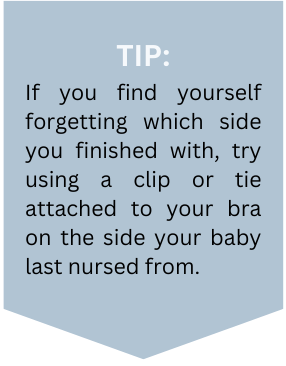Switch nursing is a technique used by breastfeeding mothers to ensure effective milk drainage from both breasts and to satisfy the baby’s hunger. It involves switching the baby from one breast to the other multiple times during a feeding session.
How it Works
- Start with One Breast – Begin nursing on one breast until the baby shows signs of slowing down or becoming less interested in feeding.
- Observe Cues – Watch for signs that the baby is no longer actively drinking, such as slower sucking motions, relaxed jaw, or falling asleep at the breast.
- Switch to the Other Breast – When you notice these signs, gently unlatch the baby from the breast and burp if necessary, then offer the other breast.
- Repeat as Needed – Continue switching breasts back and forth as long as the baby is showing interest in feeding. This may involve several switches during one feeding session.
- Start with the Opposite Breast – At the next feeding session, start with the opposite breast than the last session ended with.
Why Should you Do It?
Switch nursing presents several advantages. Firstly, it enhances milk drainage by ensuring both breasts receive adequate stimulation, aiding in effective emptying and sustaining milk supply. Additionally, it assists in awakening a drowsy baby, making feeding sessions more efficient. Moreover, alternating between breasts helps prevent one from becoming overly engorged, reducing discomfort. Furthermore, it promotes the development of a robust milk supply. Lastly, some infants may exhibit increased alertness and engagement when switched to the other breast, resulting in a more gratifying feeding for them.

Increase Milk Supply
Switch nursing can contribute to increased milk supply through several mechanisms. It enhances stimulation as the baby is switched between breasts during feeding sessions. This regular and thorough stimulation signals to the body a greater demand for milk, prompting increased milk production to meet this demand. This principle of supply and demand governs milk production in breastfeeding mothers, so increased stimulation leads to increased milk production.
Additionally, some babies may nurse more actively when switched to the other breast, stimulating the breast further and encouraging more milk production. Prolonged feedings stimulate the breast to produce more milk to meet the baby’s needs.
Balanced Breasts
Switch nursing ensures both breasts are adequately drained during each feeding. Emptying the breasts triggers the release of prolactin, the hormone responsible for milk production. Regular emptying of the breasts signals to the body to produce more milk to replenish the supply.
Alternating between breasts also prevents one breast from becoming overfull while the other remains underutilized. This balanced approach to milk removal helps maintain consistent milk production in both breasts, supporting a healthy milk supply overall.
More Satisfying Feeds
Lastly, switch nursing promotes the consumption of hindmilk, which is higher in fat and calories, providing essential nutrients for the baby’s growth and development. By ensuring the baby has access to hindmilk from both breasts, switch nursing supports optimal nutrition and may effectively satisfy the baby’s hunger.

Overall, switch nursing helps your body make more milk by keeping things active and balanced. When you switch your baby from one breast to the other during a feeding, it stimulates both breasts to produce milk. Plus, it ensures that both breasts get emptied out regularly, which signals your body to make more milk. This method also encourages your baby to nurse longer, which further boosts milk production. And by alternating sides, you’re making sure your baby gets the good stuff from both the beginning and end of each feeding, which is super important for their growth.
Switch nursing is like hitting all the right buttons to keep your milk flowing strong!



So interesting!! I do this when I feel like my baby isn’t getting much milk from me and it does help. I didn’t know there was a name for it.